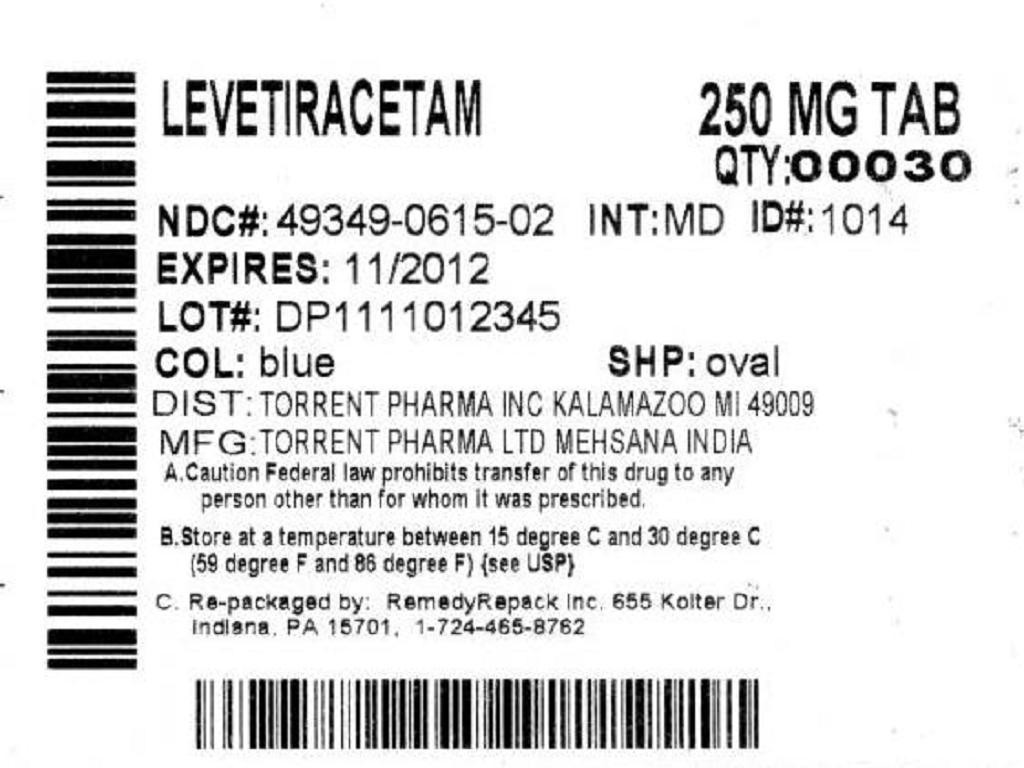Levetiractam
FULL PRESCRIBING INFORMATION: CONTENTS*
- LEVETIRACTAM DESCRIPTION
- CLINICAL PHARMACOLOGY
- PHARMACOKINETICS
- CLINICAL STUDIES
- INDICATIONS & USAGE
- LEVETIRACTAM CONTRAINDICATIONS
- WARNINGS
- PRECAUTIONS
- INFORMATION FOR PATIENTS
- LABORATORY TESTS
- DRUG INTERACTIONS
- CARCINOGENESIS & MUTAGENESIS & IMPAIRMENT OF FERTILITY
- PREGNANCY
- LABOR & DELIVERY
- NURSING MOTHERS
- PEDIATRIC USE
- GERIATRIC USE
- LEVETIRACTAM ADVERSE REACTIONS
- DRUG ABUSE AND DEPENDENCE
- OVERDOSAGE
- DOSAGE & ADMINISTRATION
- HOW SUPPLIED
- STORAGE AND HANDLING
- SPL MEDGUIDE
- PACKAGE LABEL.PRINCIPAL DISPLAY PANEL SECTION
FULL PRESCRIBING INFORMATION
LEVETIRACTAM DESCRIPTION

CLINICAL PHARMACOLOGY
Mechanism Of ActionPHARMACOKINETICS
Special PopulationsRenal ImpairmentDOSAGE AND ADMINISTRATIONAdult Patients with Impaired Renal Function
PRECAUTIONS, Drug Interactions
PRECAUTIONSDOSAGE AND ADMINISTRATION
CLINICAL STUDIES
Effectiveness In Partial Onset Seizures In Adults With Epilepsy
Study 1
***

Study 2
***

Study 3
**

Effectiveness In Partial Onset Seizures In Pediatric Patients With Epilepsy
**

**
**

INDICATIONS & USAGE
LEVETIRACTAM CONTRAINDICATIONS
WARNINGS
Suicidal Behavior and IdeationNeuropsychiatric Adverse Events
Adults
Pediatric Patients
Withdrawal Seizures
PRECAUTIONS
Hematologic AbnormalitiesAdults
Pediatric Patients
Hepatic Abnormalities
INFORMATION FOR PATIENTS
LABORATORY TESTS
DRUG INTERACTIONS
Phenytoin
Valproate
Effect Of AEDs In Pediatric Patients
Oral Contraceptives
Digoxin
Warfarin
Probenecid
CARCINOGENESIS & MUTAGENESIS & IMPAIRMENT OF FERTILITY
PREGNANCY
LABOR & DELIVERY
NURSING MOTHERS
PEDIATRIC USE
GERIATRIC USE
Use In Patients With Impaired Renal Function
CLINICAL PHARMACOLOGYDOSAGE AND ADMINISTRATION, Adult Patients with Impaired Renal Function
LEVETIRACTAM ADVERSE REACTIONS
Partial Onset Seizures
Time Course Of Onset Of Adverse Events For Partial Onset Seizures
Discontinuation Or Dose Reduction In Well-Controlled Clinical Studies
Comparison Of Gender, Age And Race
Postmarketing Experience
DRUG ABUSE AND DEPENDENCE
OVERDOSAGE
Signs, Symptoms And Laboratory Findings Of Acute Overdosage In HumansTreatment Or Management Of Overdose
Hemodialysis
DOSAGE & ADMINISTRATION
Partial Onset Seizures
CLINICAL STUDIES
Adult Patients With Impaired Renal Function
HOW SUPPLIED
STORAGE AND HANDLING
SPL MEDGUIDE
Levetiracetam Tablets, USPRx Only
What is the most important information I should know about levetiracetam?
Like other antiepileptic drugs, levetiracetam may cause suicidal thoughts or actions in a very small number of people, about 1 in 500 people taking it.
Call a healthcare provider right away if you have any of these symptoms, especially if they are new, worse, or worry you:
-
● thoughts about suicide or dying
-
● attempts to commit suicide
-
● new or worse depression
-
● new or worse anxiety
-
● feeling agitated or restless
-
● panic attacks
-
● trouble sleeping (insomnia)
-
● new or worse irritability
-
● acting aggressive, being angry, or violent
-
● acting on dangerous impulses
-
● an extreme increase in activity and talking (mania)
-
● other unusual changes in behavior or mood
-
● Stopping levetiracetam suddenly can cause serious problems. Stopping a seizure medicine suddenly can cause seizures that will not stop (status epilepticus).
-
● Suicidal thoughts or actions can be caused by things other than medicines. If you have suicidal thoughts or actions, your healthcare provider may check for other causes.
-
● Pay attention to any changes, especially sudden changes, in mood, behaviors, thoughts, or feelings.
-
● Keep all follow-up visits with your healthcare provider as scheduled.
-
● Call your healthcare provider between visits as needed, especially if you are worried about symptoms.
-
● partial onset seizures in people 4 years of age and older with epilepsy
-
● myoclonic seizures in people 12 years of age and older with juvenile myoclonic epilepsy
-
● primary generalized tonic-clonic seizures in people 6 years of age and older with certain types of generalized epilepsy.
-
● 250 mg levetiracetam tablets, USP are blue colored, oval shaped, film-coated tablets debossed with breakline separating250'andMG'on one side and1014'on other side.
-
● 500 mg levetiracetam tablets, USP are yellow colored, oval shaped, film-coated tablets debossed with breakline separating500'andMG'on one side and1015'on other side.
-
● 750 mg levetiracetam tablets, USP are orange colored, oval shaped, film-coated tablets debossed with breakline separating750'andMG'on one side and1016'on other side.
-
● 1000 mg levetiracetam tablets, USP are white to off white, oval shaped, film-coated tablets debossed with breakline separating1000'andMG'on one side and1017'on other side.
-
● have or have had depression, mood problems or suicidal thoughts or behavior
-
● have kidney problems
-
● are pregnant or planning to become pregnant. It is not known if levetiracetam will harm your unborn baby. You and your healthcare provider will have to decide if you should take levetiracetam while you are pregnant. If you become pregnant while taking levetiracetam, talk to your healthcare provider about registering with the North American Antiepileptic Drug Pregnancy Registry. You can enroll in this registry by calling 1-888-233-2334. The purpose of this registry is to collect information about the safety of levetiracetam and other antiepileptic medicine during pregnancy.
-
● are breast feeding. Levetiracetam can pass into your milk and may harm your baby. You and your healthcare provider should discuss whether you should take levetiracetam or breast-feed; you should not do both.
How should I take levetiracetam?
-
● Your healthcare provider will tell you how much levetiracetam to take and when to take it. Levetiracetam is usually taken twice a day. Take levetiracetam at the same times each day.
-
● Your healthcare provider may change your dose. Do not change your dose without talking to your healthcare provider.
-
● Take levetiracetam with or without food.
-
● Swallow the tablets whole. Do not chew or crush tablets. Ask your healthcare provider for levetiracetam oral solution if you cannot swallow tablets.
-
● If your healthcare provider has prescribed levetiracetam oral solution, be sure to ask your pharmacist for a medicine dropper or medicine cup to help you measure the correct amount of levetiracetam oral solution. Do not use a household teaspoon. Ask your pharmacist for instructions on how to use the measuring device the right way.
-
● If you miss a dose of levetiracetam, take it as soon as you remember. If it is almost time for your next dose, just skip the missed dose. Take the next dose at your regular time. Do not take two doses at the same time.
-
● If you take too much levetiracetam, call your local Poison Control Center or go to the nearest emergency room right away.
What are the possible side effects of levetiracetam?
-
● See "What is the most important information I should know about levetiracetam?"
-
● mood and behavior changes such as aggression, agitation, anger, anxiety, apathy, mood swings, depression, hostility, and irritability. A few people may get psychotic symptoms such as hallucinations (seeing or hearing things that are really not there), delusions (false or strange thoughts or beliefs) and unusual behavior.
-
● extreme sleepiness, tiredness, and weakness
-
● problems with muscle coordination (problems walking and moving)
-
● sleepiness
-
● weakness
-
● dizziness
-
● infection
-
● accidental injury
-
● irritability
-
● hostility
Call your doctor for medical advice about side effects. You may report side effects to FDA at 1-800-FDA-1088.
How should I store levetiracetam?
-
● Store levetiracetam at room temperature, 59to 86(15to 30away from heat and light.
-
● Keep levetiracetam and all medicines out of the reach of children.
What are the ingredients of levetiracetam?
Levetiracetam tablet,
PACKAGE LABEL.PRINCIPAL DISPLAY PANEL SECTION


LevetiractamLevetiracetam TABLET
| ||||||||||||||||||||||||||||||||||||||||||||||||||||||||||||||||||||||||||||||||||||||
PLEASE, BE CAREFUL!
Be sure to consult your doctor before taking any medication!